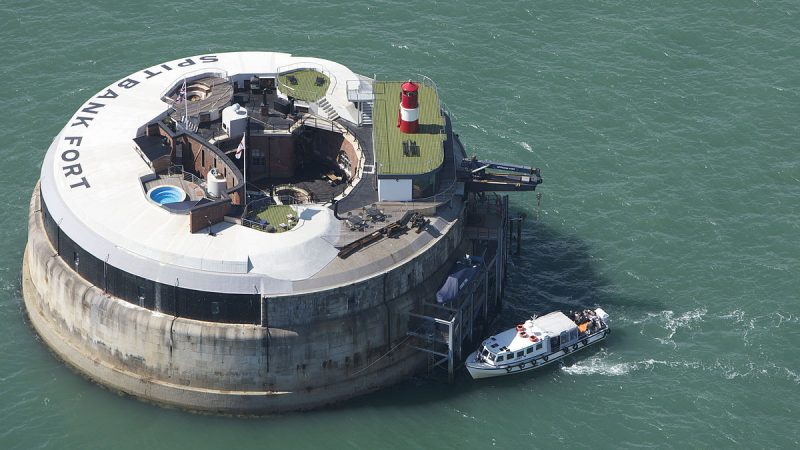Looking for a truly unforgettable adventure off the south coast of England? The Solent Forts—a group of historic sea forts located in the waters between Portsmouth and the Isle of Wight—offer one of the UK’s most unique experiences. Originally built in the 19th century to defend against French invasion, these maritime structures have since been transformed into luxury hotels, museums, and event spaces. Whether you’re a history buff, curious traveler, or seeking an exclusive escape, visiting the Solent Forts is like stepping into another world. In this guide, we’ll explore the history, current uses, and how to visit these fascinating landmarks.
What Are the Solent Forts?
The Solent Forts are a collection of five artificial island forts constructed in the 1860s and 1870s to protect Portsmouth Harbour and the Solent strait from naval attack. They are:
- Spitbank Fort
- No Man’s Fort
- Horse Sand Fort
- St Helens Fort
- Sandown Fort (now demolished)
Built from granite and iron, these sea forts are remarkable feats of Victorian engineering and are often referred to as “Palmerston’s Follies”, named after then-Prime Minister Lord Palmerston who commissioned their construction.
Where Are the Solent Forts Located?
Situated in the Solent, a strait separating the Isle of Wight from mainland England, the forts are easily accessible by boat from Portsmouth, Gosport, and Southsea.
- Distance from Portsmouth: ~1.5 miles offshore
- Boat access: Typically 15–25 minutes by private charter or guided tour
Explore the Forts: What Each Solent Fort Offers
Spitbank Fort
- Current Use: Luxury boutique hotel (subject to reopening plans)
- Features: 9 luxury suites, rooftop hot tub, fire pit, fine dining restaurant
- Best For: Romantic getaways, private events, luxury travel
- Fun Fact: Frequently used for high-end weddings and corporate retreats
No Man’s Fort
- Current Use: Previously operated as a larger hotel and event venue
- Features: 22 bedrooms, lighthouse tower, cabaret bar, rooftop fire pits
- Best For: Group getaways, weddings, and themed parties
- Size: The largest of the Solent Forts, 99,000 square feet
Horse Sand Fort
- Current Use: Historical site and museum (limited public access)
- Features: Preserved Victorian military layout, eerie tunnels, and barracks
- Best For: History lovers and ghost tour fans
- Note: Less commercialized—exploration is often via special heritage tours
St Helens Fort
- Current Use: Private property, not open to public
- Famous For: The annual St Helens Fort walk—a rare natural event where locals walk across the sandbanks at low tide
History of the Solent Forts
Constructed between 1867 and 1880, the Solent Forts were designed as a defensive ring during a period of Anglo-French tension. Ironically, by the time they were completed, the threat had passed, and the forts never saw active combat.
Over the decades, the forts served various roles—from training sites and signaling stations to abandoned relics—before being reinvented in the 21st century as heritage and luxury destinations.
How to Visit the Solent Forts
Access Options:
- Guided Boat Tours – Depart from Gunwharf Quays, Portsmouth Historic Dockyard, or Southsea Marina
- Private Charters – Available for groups, photo shoots, and event hire
- Hotel Stays – When operational, overnight stays offer the best access to Spitbank or No Man’s Fort
- Special Events – Keep an eye out for open days or seasonal tours via heritage organizations
Tip: Always check for seasonal availability or current closures before planning your trip, as some forts may be under renovation or sale.
Things to Do During Your Visit
- Tour the Victorian architecture and hidden tunnels
- Enjoy panoramic sea views from the rooftops
- Attend a private dining experience or wine tasting
- Explore historic gun emplacements and living quarters
- Book a wellness treatment in the spa (available at Spitbank Fort)
- Discover tales of wartime service and rumored ghost sightings
Solent Forts for Special Occasions
The unique layout and exclusivity of the Solent Forts make them ideal for:
- Weddings
- Birthday parties
- Corporate retreats
- Photoshoots and film sets
- Romantic stays (with helicopter or yacht access options)
Conclusion
The Solent Forts are a testament to British naval history and Victorian ingenuity—now reimagined as some of the most exclusive and atmospheric destinations in the UK. Whether you’re looking for a luxurious escape, a unique historical tour, or a stunning coastal photo opportunity, visiting the Solent Forts is an experience like no other. With a blend of heritage, hospitality, and horizon-spanning views, these incredible structures bring the past to life in the most unforgettable way.
FAQs
1. Are the Solent Forts open to the public?
Spitbank and No Man’s Fort have operated as luxury hotels but may have limited access. Horse Sand Fort is occasionally open via guided heritage tours.
2. How can I get to the Solent Forts?
Access is only by boat, typically from Portsmouth. Private charters and organized tours are the best options.
3. Can I stay overnight at a Solent Fort?
Yes, when operating, both Spitbank Fort and No Man’s Fort offer overnight stays with luxury amenities.
4. Are the Solent Forts haunted?
Several reports and tours suggest paranormal activity, especially at Horse Sand Fort, adding a spooky thrill for ghost hunters.
5. Are the forts suitable for children?
Some tours and stays are family-friendly, but always check age restrictions when booking.
Also read: Lords of the Manor Hotel: A Luxury Cotswolds Escape in the Heart of Upper Slaughter









